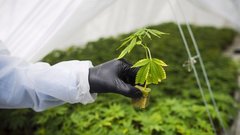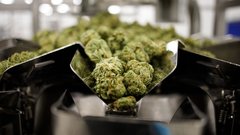May 30, 2020
Canada's 'Croptober' looms as outdoor pot production set to soar
We'll be using capital as a war chest to develop products consumers want from us: Canopy CEO
A different sea of green will greet Canadian farm fields this year as licensed producers begin planting their cannabis outdoors, a move that could exacerbate an existing glut in the market and potentially cause further industry writedowns.
Health Canada said that about 450 acres of land were used for outdoor cannabis cultivation last year, compared with roughly 350 acres grown indoors. This year, 46 licensed producers can grow cannabis outdoors, almost double the number of licensees from last year. Another 70 companies are still waiting for regulatory approvals.
While it's unknown how much cannabis will be produced this year with some greenhouses shut in order to cut costs and due to difficulties working amid the COVID-19 pandemic, the increase in outdoor growers may mirror a "Croptober" event previously seen in some U.S. states like Oregon and Washington. “Croptober" refers to the period in the fall when supply from outdoor harvests flood the market with existing production from indoor facilities.
"It's a weird place for the Canadian market to be in right now," said Marc Geen, chairman and founder of Speakeasy Cannabis Club Ltd,, in a phone interview. "If you're not able to produce what the public wants, what the hell are you doing in the business?"
After spending millions of dollars buildings customized facilities and greenhouses to grow cannabis indoors, cultivating pot outside can be done for a fraction of the cost – as little as four cents a gram, some producers told BNN Bloomberg.
Cannabis Benchmarks, which analyzes price data in the cannabis industry, said outdoor cannabis grown in Oregon was sold for about US$500 per pound during "Croptober," roughly one-quarter of what the firm's spot cannabis price in Canada currently sits at.
While much of that biomass usually gets refined and turned into products such as vapes or gummies, it also causes cannabis prices to bottom out, something that could hurt companies still seeking positive cash flow.
It's already impacted Canopy Growth Corp., the largest cannabis company in Canada. The Smiths Falls, Ont.-based producer shut down two major B.C. greenhouses in March, while relying on roughly 200 acres of farmland in Saskatchewan to grow pot outdoors, which the company said was "more cost-effective." A Canopy spokesperson said in an email that its Saskatchewan harvest will "play an important role in our product mix" but declined to specify the company's outdoor plans.
Aurora Cannabis Inc., which has also curtailed some of its production, is looking at whether it’s feasible to use its 207-acre land in Westwold, B.C. to "supplement our large scale greenhouse facilities," a company spokesperson told BNN Bloomberg in an email.’
Aleafia Health Inc., meanwhile, touted its cost per gram of cannabis grown outdoors last year came to 10 cents, roughly one-tenth the average cost to grow pot in an indoor facility. This year, Aleafia's Chief Executive Officer Geoff Benic expects that number to be even lower.
"You can get 90 per cent of the same cannabinoid content in outdoor compared to an indoor facility for a fraction of the cost," said Benic in a phone interview. "We're a scaled business so we need to look at our operations to get the best quality product into consumer's hands at the best price. There's no other way I know how but with outdoor. It's a game-changer."
But as the industry looks to shrug off a period of impairment charges caused by overly-ambitious expectations and pricing declines in the wholesale market, millions of dollars of further writedowns could happen if indoor producers compete with outdoor grows by pumping out more of their product, according to some analysts.
"It's likely going to drive another cycle of writedowns across the board," said Rahul Sarugaser, an analyst with Raymond James, in a recent phone interview with BNN Bloomberg.
"It depends on how accounting firms allow companies to value cannabis that's on their books. I feel that auditors have been burned enough by now that they'll value the cannabis at the same price regardless if it's grown indoors or outdoors."
Speakeasy's Geen goes further, anticipating bankruptcies if producers are unable to sell any indoor product at a price higher than it costs to grow it. The company plans to grow about 68,000 kilograms of outdoor cannabis, much of it earmarked for the wholesale market, across 60 acres after spending two years testing strains to see which would work best outside, Geen added.
"Greenhouses are a dinosaur technology," Geen said. "There's just no place in the market for that and producers are beginning to realize it."
Alex Rumi, chief strategy officer of Good Buds Company Inc., the first company that was allowed to grow legal cannabis outside in Canada, said it plans to use lessons learned last year to improve the quality and yield this year's harvest. That includes narrowing down the strains used to three from 25.
Rumi added the B.C.-based producer is planting 80,000 seeds across 12 acres of land in the hopes of growing about 8,000 kilograms of pot, which will help Good Buds expand its pre-roll and extract product offerings nationally.
"As long as you're differentiating yourself as a connoisseur product for people who really care about weed, that's a good defense against the commoditization of the product," Rumi said.






